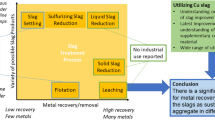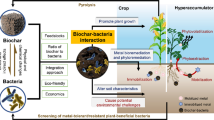Abstract
Several million metric tons of mining wastes, called stamp sands, were generated in the Upper Peninsula of Michigan during extensive copper (Cu) mining activities in the past. These materials, containing large amounts of Cu, were discharged into various offshoots of Lake Superior. Due to evidences of Cu toxicity on aquatic organisms, in due course, the materials were dredged and dumped on lake shores, thus converting these areas into vast, fallow lands. Erosion of these Cu-contaminated stamp sands back to the lakes is severely affecting aquatic life. A lack of uniform vegetation cover on stamp sands is facilitating this erosion. Understanding the fact that unless the stamp sands are fertilized to the point of sustaining vegetation growth, the problem with erosion and water quality degradation will continue, amending the stamp sands with locally available biosolids and composts, was considered. The purpose of the reported study was to assess potential effects of such organic fertilizer amendments on soil quality. As the first step of a combined laboratory and greenhouse study, a 2-month-long incubation experiment was performed to investigate the effects of biosolids and compost addition on the soil nutrient profile of stamp sands and organic matter content. Results showed that both biosolids and compost amendments resulted in significant increase in nitrogen and phosphorus concentrations and organic matter contents of stamp sands. Sequential extraction data demonstrated that Cu was mostly present as bound forms in stamp sands, and there was no significant increase in the plant available fraction of Cu because of fertilizer application.






Similar content being viewed by others
References
Boyl, M., & Paul, E. P. (1989). Carbon and nitrogen mineralization kinetics in soils previously amended with sewage sludge. Soil Science Society of America Journal, 53, 99–103.
Brown, S. L., Chaney, R. L. Angle J. S. & Ryan, J. A. (1998). Organic carbon and the phytoavailability of cadmium to lettuce in long term biosolids amended soils. Journal of Environmental Quality, 27, 1071–1078.
Brown, S. L., Henry, C. L., Chaney, R., Compton, H., & DeVolder, P. S. (2003). Using municipal biosolids in combination with other residuals to restore metal-contaminated mining areas. Plant and Soil, 249, 203–215.
Cusack, C., & Mihelcic, J. (1999). Sediment toxicity from copper in the torch lake (MI) great lakes area of concern. Journal of Great Lakes Research, 25(4), 735–743.
Debosz, K., Petersen, S. O., Kure, L. K., & Ambus, P. (2002). Evaluating effects of sewage sludge and household compost on soil physical, chemical and microbiological properties. Applied Soil Ecology, 19, 237–248.
Eghball, B. (2002). Soil properties as influenced by phosphorus- and nitrogen-based manure and compost applications. Agronomy Journal, 94, 128–135.
Elliott, H. A., O’Connor, G. A., & Brinton, S. (2002). Phosphorus leaching from biosolids-amended sandy soils. Journal of Environmental Quality, 31, 681–689.
Gee, G. W., & Bauder, J. W. (1986). Physical and mineralogical methods. Agronomy monograph No. 9. In A. Klute (Ed.), Methods of soil analysis, Part 1. Particle-size analysis (2nd ed., pp. 383–411). Madison: American Society of Agronomy/Soil Science Society of America.
Guerra, P., Ahumada, I., & Carrasco, A. (2007). Effect of biosolid incorporation to mollisol soils on Cr, Cu, Ni, Pb, and Zn fractionation, and relationship with their bioavailability. Chemosphere, 68, 2021–2027.
Haering, K. C., Daniels, W. L., & Feagly, S. E. (2000). Reclaiming mined lands with biosolids, manures and papermill sludges. In R. Barnhisel (Ed.), Reclamation of drastically disturbed lands (pp. 615–644). Madison: Soil Science Society of America, Inc.
Li, Y. M., Chaney, R. L., Siebielec, G., & Kerschner, B. A. (2000). Response of four turfgrass cultivars to limestone and biosolids-compost. Journal of Environmental Quality, 29, 1440–1447. Amendment of a zinc and cadmium-contaminated soil at Palmerton, Pennsylvania.
MDPH (1983) The Michigan Department of Public Health, now the Michigan Department of Community Health (MDCH), issued a fish consumption advisory on sauger and walleye in for Torch Lake, Houghton County based on fish tumors of unknown origin.
Maguire, R. O., Sims, J. T., & Coale, F. J. (2000). Phosphorus solubility in biosolids-amended farm soils in the Mid-Atlantic region of the USA. Journal of Environmental Quality, 29, 1225–1233.
Maguire, R.O., Sims, J.T., McGrath, J.M. & Angel, C.R. (2003). Phytase and 25OH-D3 in turkey diets affect phosphorus solubility in manure-amended soils. Soil Science, 168, 421–433.
Mehlich, A. (1984). Mehlich 3 soil test extractant: a modification of Mehlich 2. Communications in Soil Science and Plant Analysis, 15, 1409–1416.
Michigan Department of Environmental Quality (MDEQ). (2007). Biennial remedial action plan update for the torch lake area of concern. Lansing: MDEQ.
Moffet, C. A., Zartman, R. E., Wester, D. B., & Sosebee, R. E. (2005). Surface biosolids application: effects on infiltration, erosion, and soil organic carbon in Chihuahuan Desert grasslands and shrublands. Journal of Environmental Quality, 34, 299–311.
Nelson, D.W., & Sommers, L.E. (1982). Total carbon, organic carbon and organic matter. In A. L. Page, R. H. Miller, & D. R. Keeney (eds.) Methods of soil analysis. Part 2. Agronomy, 9, 539–579.
O’Connor, G. A., & Sarkar, D. (2002). Fate of land applied residuals-bound phosphorus. Contract no. WM-661. Final Rep. Tallahassee: Florida Department of Environmental Protection.
Rivero, C. T., Chirenje, T., Ma, L. Q., & Martinez, G. (2004). Influence of compost on soil organic matter quality under tropical conditions. Geoderma, 123, 355–361.
SAS Institute Inc. (2012). JMP® version 10. Cary: SAS Institute Inc.
Schulte, E. E., & Hopkins, B. G. (1996). Estimation of soil organic matter by weight-loss-on-ignition. In F. R. Magdoff et al. (Eds.), Soil organic matter: analysis and interpretation (p. 46). Madison: SSSA Spec. Publ.
Shober, A. L., Stehouwer, R. C., & Macneal, K. E. (2003). On-farm assessment of biosolids effects on soil and crop tissue quality. Journal of Environmental Quality, 32, 1873–1880.
Sopper, W. E. (1993). Municipal sludge use for land reclamation. Ann Arbor: Lewis.
Sparks, D. L. (1996). Methods of soil analysis. Part 3. Chemical methods. Madison: SSSA.
Su, D. C., & Wong, J. W. C. (2003). Chemical speciation and phytoavailability of Zn, Cu, Ni and Cd in soil amended with fly ash-stabilized sewage sludge. Environment International, 29, 895–900.
Tessier, A., Campbell, P. G. C., & Bisson M. (1979). Sequential extraction procedure for the speciation of particulate trace metals. Analytical Chemistry, 51(7), 844–851.
Tian, G., Granato, T. C., Cox, A. E., Pietz, R. I., Carlson, C. R., Jr., & Abedin, Z. (2009). Soil carbon sequestration resulting from long-term application of biosolids for land reclamation. Journal of Environmental Quality, 38, 61–74.
Torch Lake Township (TLT). (2015). Health and safety concerns at Hubbell beach. http://www.torchlaketownship.com/News+and+Views/7234.aspx.
US EPA. (1986). Comprehensive environmental response, compensation, and liability act national priorities list.
US EPA. (1989). Torch Lake, remedial investigation/feasibility study, Houghton county, Michigan, volume 1A, Final Work Plan, US EPA Contract 68-W8-0093. Donohue & Associates, Inc.
US EPA. (1995). A guide to the biosolids risk assessments for the EPA part 503 rule. EPA 832-B-93-005. Office of Wastewater Management. Washington, DC: USEPA.
US EPA. (1996). Test methods for evaluating solid waste. SW 846, office of solid waste and emergency response (3rd ed.). Washington, D.C.: USEPA.
Vitosh, M.L., Johnson, J.W., & Mengel, D.W. (1995). Tri-state fertilizer recommendations for corn, soybeans, wheat and alfalfa. Bulletin. Ohio State University.
Weston Solutions, Inc. (Weston). (2007). Summary report for the torch lake area assessment: Torch Lake NPL site and surrounding areas Keweenaw Peninsula, Michigan. Prepared for US EPA. Document No.: 274-2A-ABDT.
Acknowledgments
We thank the Portage Lake Water and Sewage Authority (PLWSA), Houghton, Michigan, for providing the biosolids for the study. We also thank Dr. Ramana Reddy and Jeffrey Kiiskila for their help in the collection of stamp sands.
Author information
Authors and Affiliations
Corresponding author
Rights and permissions
About this article
Cite this article
Sidhu, V., Sarkar, D. & Datta, R. Effects of biosolids and compost amendment on chemistry of soils contaminated with copper from mining activities. Environ Monit Assess 188, 176 (2016). https://doi.org/10.1007/s10661-016-5185-7
Received:
Accepted:
Published:
DOI: https://doi.org/10.1007/s10661-016-5185-7




